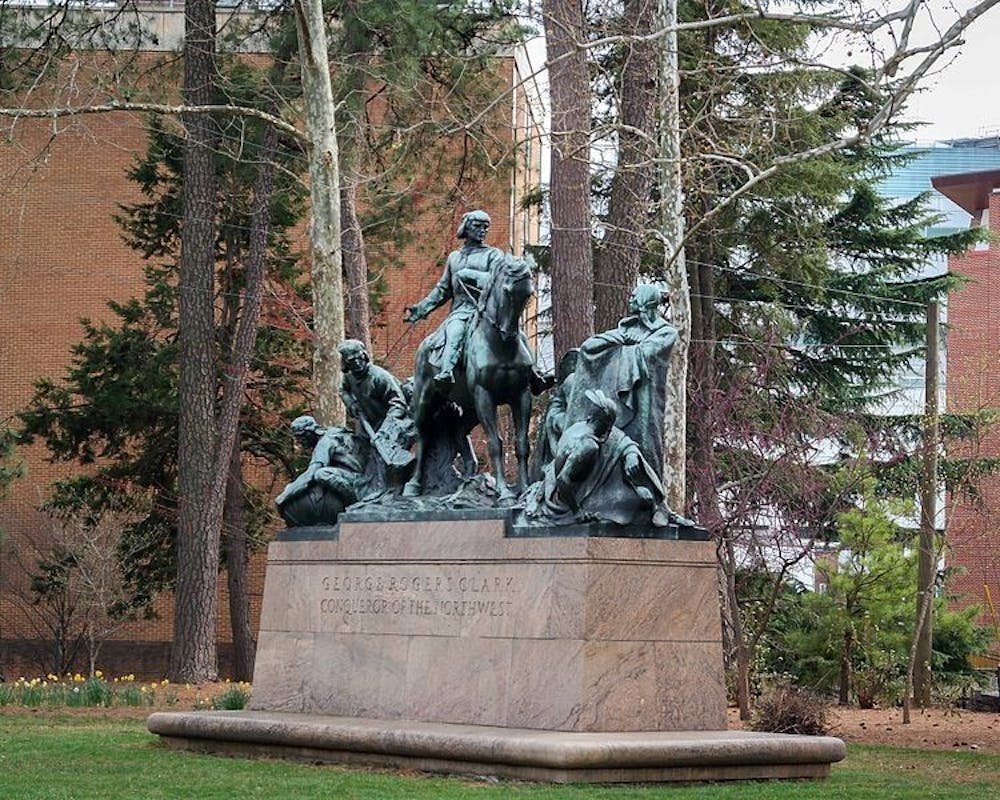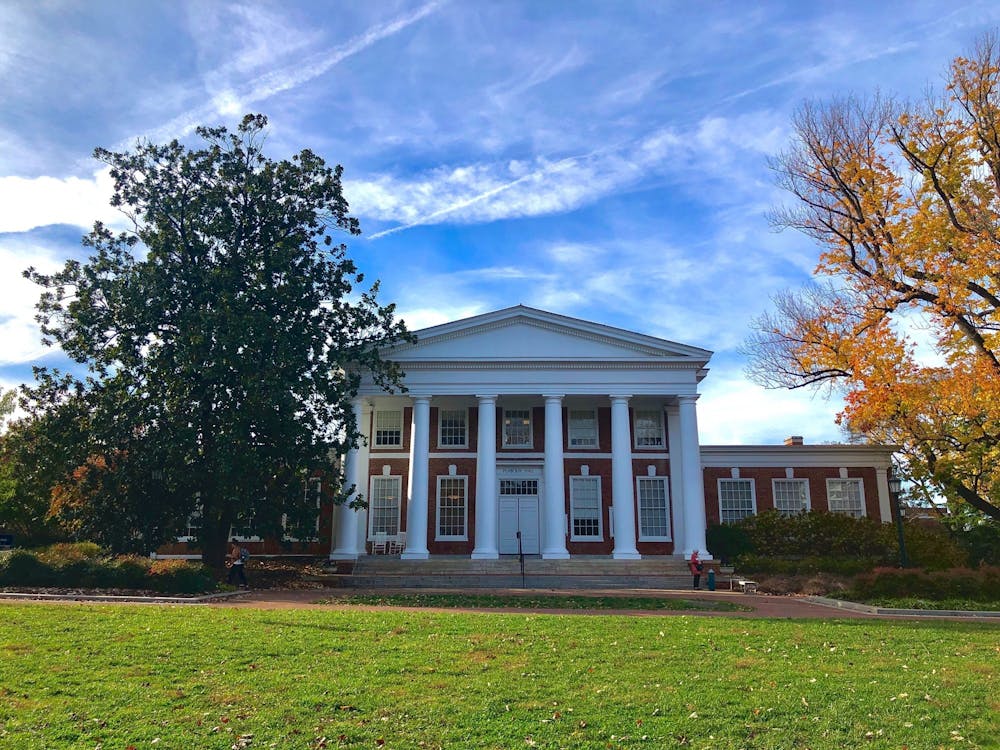Nationwide protests in response to the death of George Floyd and police brutality have reignited debate over the removal of statues commemorating Confederate war generals and other insensitive depictions in both Richmond and Charlottesville. Both Gov. Ralph Northam, D-Va., and Charlottesville’s City Council have announced commitments to removing their statues of Confederate General Robert E. Lee.
Like Richmond, the City of Charlottesville also has many other statues whose presence have ignited debate. On June 7, an estimated 1,000 peaceful demonstrators marched from downtown to the Rotunda calling for the removal of Confederate statues and an end to police brutality against the Black community.
The fate of the George Rogers Clark statue, which is located on Grounds near the Corner, lies in the hands of the University. The 24-foot-tall statue was erected in 1921 and depicts Clark, a Revolutionary War general, on horseback with a group of Native Americans kneeling in front of him. It was found vandalized in November and months earlier, local activist David Swanson circulated a petition calling for its removal.
Delegate Sally Hudson, a University professor, said that she supports the removal of Confederate monuments from public spaces and noted that the George Rogers Clark statue is “especially horrifying.”
“It's actively violent — a white man trampling an indigenous woman and child,” Hudson said in an email statement to The Cavalier Daily. “Why should we at U.Va. want that image at the gateway to our Grounds, to our hospital?”
The George Rogers Clark statue is also included in a more recent petition that demands all streets, buildings and departments mentioned be renamed and all monuments be removed. The petition was coauthored by rising fourth-year College students Emmy Monaghan and Mara Guyer, recent College graduate Mike Seay and the Brown College Portal Renaming Committee.
“In continuing to celebrate slaveholders, Confederates, eugenicists, and racists through monuments, buildings, and school departments, U.Va. cannot claim to commit to the Black Lives Matter movement,” the petition reads.
Monaghan said that she started this petition to combine several other efforts being made to remove memorials and statues around Grounds. She also said that while it is great that the University has finally finished construction on the Memorial to Enslaved Laborers, it should not have taken over a decade of student advocacy to erect a long-overdue monument.
“I don't think U.Va. should expect anyone to be satisfied with a single monument that honors 5,000 enslaved laborers when white supremacists each get their own building,” Monaghan said. “I also wonder how [University President] Jim Ryan can live in a house named after a slaveholder while emailing students about his commitment to racial justice. It doesn't add up.”
The petition will be forwarded to the racial equity task force announced by President Ryan, which is led by Ian Solomon, dean of the Frank Batten School of Leadership and Public Policy; Kevin McDonald, vice president for Diversity, Equity and Inclusion; and Barbara Brown Wilson, assistant professor in the School of Architecture and faculty director of the Equity Center.
Wes Hester, deputy spokesperson and director of media relations for the University, said that the issue of removing the statue of George Rogers Clark has been referred to the President’s Commission on the University in the Age of Segregation, whose work has been put on hold due to the COVID-19 pandemic.
Another petition, coauthored by rising second-year College students Chloe Leon and Abena Sekum Appiah-Ofori, calls on the University to remove the Whispering Wall — officially named the Frank Hume Memorial Fountain — which was originally built as a memorial to Frank Hume, a Confederate soldier who served in the Virginia legislature.
“U.Va. can’t in one breath say that they want to honor those who built the University from the ground up but then keep the memorial of a man who fought to keep these same people enslaved,” Appiah-Ofori said in an interview with The Cavalier Daily. “It’s completely hypocritical.”
Though some students and alumni have suggested to Appiah-Ofori that the Whispering Wall just be rededicated to someone else, she said that anything other than removal would be insufficient. Appiah-Ofori said that she’d be happy to see the University’s Architecture students design a new concept to replace the Whispering Wall.
The petition has been sent to President Ryan, and the list of demands will be shared with the racial equity task force.
Efforts to remove Charlottesville’s Lee statue, which stands in the city’s Market Street Park — formerly Emancipation Park and before that, Lee Park — date back to 2016 when Zyahna Bryant, a rising second-year College student and community activist, created a petition calling for action. The City responded by establishing a Blue Ribbon Commission on Race, Memorials and Public Spaces to review the Lee statue and consider the future of Charlottesville’s Confederate monuments. In 2017, City Council voted three to two in favor of removing the Robert E. Lee statue.
Numerous plaintiffs, including the Monument Fund, a nonprofit dedicated to protecting monuments, filed a lawsuit seeking to prevent the statue’s removal. Due to a state law prohibiting localities from disturbing monuments, the court issued a permanent injunction preventing the City from taking further action.
Now that new legislation goes into effect July 1, however, the Monument Fund has asked the judge to adapt the language of the current injunction to reflect the new law. In a press statement June 5, the group noted that the legislation will not permit localities to damage or destroy the statues — rather, it requires them to be relocated.
According to the Monument Fund, the group has received a donation that would allow them to relocate the Charlottesville Lee statue to a different location — such as a “museum, historical society, government, or military battlefield” — still accessible to the public.
In an email to The Cavalier Daily, City Council affirmed its commitment to removing the statue under the new law and said they are currently working with legal counsel to pursue the necessary steps to dissolve the injunction and conduct a public hearing about the removal.
The Lee statue has been no stranger to controversy, particularly in recent years. In December, the statue was vandalized with the words “This is Racist” and “IMPEACH TRUMP.” Back in 2017, Lee’s monument was at the forefront of national news when neo-Nazis held a Unite the Right rally to protest the City's vote to remove the statue.
Following protests throughout Richmond — and across the state of Virginia — over the death of George Floyd, Northam announced June 4 that Lee’s statue would be removed after 130 years.
“I believe in a Virginia that learns lessons from the past, and we all know that our country needs that example right now," Northam said. "America is once again looking to Virginia to lead.”
Richmond’s Monument Avenue hosts six monuments, five of which honor confederate veterans. Confederate General Robert E. Lee’s statue was the first to be constructed after the Civil War.
The exact date has yet to be announced, but crews inspected the monument June 8 in an effort to decide how to safely remove the statue, which weighs 12 tons and is 21 feet tall.
However, last week, a judge issued an indefinite injunction blocking the removal of the Lee statue after William C. Gregory filed a lawsuit claiming that the state promised to guard and protect the memorial. Gregory is a descendant of two signatories of the deed to the land on which the statue rests.
“His family has taken pride for 130 years in this statue resting upon land belonging to his family and transferred to the Commonwealth in consideration of the Commonwealth contractually guaranteeing to perpetually care for and protect the Lee Monument,” the lawsuit reads.
Despite the setback, Northam’s press secretary Alena Yarmosky said that the governor still plans to remove the statue and is confident in his authority to do so. Attorney General Mark Herring also said that he plans to defend the governor’s decision, noting that Northam has both the “authority and moral obligation” to do so.
An additional lawsuit was filed June 15 on behalf of six residents of Monument Avenue who believe they may lose tax credits and property value if Lee’s statue is removed. The suit has been referred to a federal court.
In a press statement regarding the lawsuit, Herring’s press secretary Charlotte Gomer said that the attorney general is committed to ensuring the removal of the statue.
Virginia has seen efforts to remove other statues as well. In Byrd Park — located at the end of Arthur Ashe Boulevard in Richmond — protestors used ropes to take down a statue of Christopher Columbus June 9 and dragged it to the Fountain Lake, where it was recovered the following morning. Videos show that the statue was also briefly set on fire.
Richmond Mayor Levar Stoney tweeted that though Columbus inflicted atrocities on indigenous people, the decision and action to remove a monument should be made in collaboration with the community.
The next day, protestors also took down the statue of Jefferson Davis, the former president of the Confederacy, located on Monument Avenue. The statue was left in the street, where it was retrieved by a tow truck that night.
“Jefferson Davis was a racist & traitor who fled our city as his troops carried out orders to burn it to the ground,” Stoney tweeted. “He never deserved to be up on that pedestal.”
Stoney went on to ask the public to allow the statue to be removed both legally and professionally.
In a press statement, Stoney said that he plans to introduce legislation to officially remove the four Confederate statues on Monument Avenue — other than Lee, which is in the hands of the Governor — after July 1, when a new law will go into effect allowing localities to remove, relocate or contextualize Confederate statues and monuments. The law was passed by the General Assembly this year and overturns previous legislation banning officials from interfering with monuments.
“Times have changed, and removing these statues will allow the healing process to begin for so many Black Richmonders and Virginians,” Stoney said. “Richmond is no longer the capital of the Confederacy – it is filled with diversity and love for all – and we need to demonstrate that.” .






